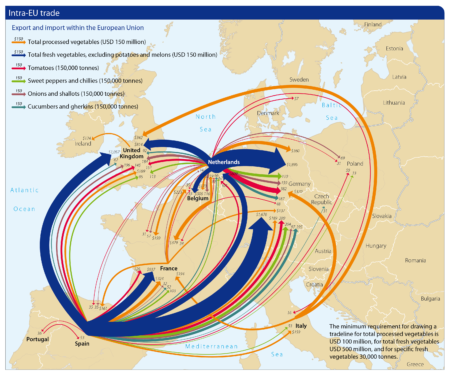- Martha goes to Svalbard. No sign of Snoop.
- The Chileman. No, not Chillyman. Nothing to do with Svalbard.
- Little nuts. Nothing to do with the Chileman.
- Red stinkwood is a lot nicer than it sounds. I’ve got a couple myself.
- O’Keeffe’s pineapples.
- Citizen science gets to grips with soybeans in Germany.
- Colin Leakey, he of the fartless beans, passes away.
- How the kiwi fruit was saved.
- The real wasabi.
Brainfood: Lupinus diversity, African veggies, School food, Citrus collusion, Taro seeds, Hot seeds, Hunter-gatherers, Citrus phylogeny, Sheep management, Genebanks -> farmers
- Exploring the genetic and adaptive diversity of a pan-Mediterranean crop wild relative: narrow-leafed lupin. W-E migration.
- From lesser-known to super vegetables: the growing profile of African traditional leafy vegetables in promoting food security and wellness. I’m sold.
- Home-grown school feeding: promoting local production systems diversification through nutrition sensitive agriculture. Any traditional leafy greens, though?
- Citrus genebank collections: international collaboration opportunities between the US and Russia. Very complementary.
- Adapting clonally propagated crops to climatic changes: a global approach for taro (Colocasia esculenta (L.) Schott). The need for seed.
- High-temperature drying of seeds of wild Oryza species intended for long-term storage. The need for drying seeds at 45°C.
- Productivity, biodiversity, and pathogens influence the global hunter-gatherer population density. Come the zombie apocalypse, head for subtropical and temperate forest biomes.
- Genomics of the origin and evolution of Citrus. It all started when the SE foothills of the Himalayas got a bit dryer in the Miocene… But there’s only one genus (well, plus Poncirus), with 10 species. Oh and pummelos are really important.
- Sheep herding systems and animal genetic resource management in the Central Plateau region of Burkina Faso. The best strategy overall would be for rural breeders to specialize in maintaining purebreds and urban breeders, closer to markets, fattened F1 crossbreds. But that’s easier said than done.
- Access to genes: linkages between genebanks and farmers’ seed systems. You can do it in half a dozen different ways, but there are challenges with scale, sustainability and legal frameworks.
Nibbles: Svalbard, Irish Seed Savers Association podcast, Heirloom tomatoes, Rice genomes, Avocado history, 3D seeds, Agroforestry, Canarium development, IK, Indian nutrition, Biofortification, Salvia, Biorepositories best practices, Neurolathyrism
- The Smallholder on Svalbard. Martha unavailable for comment.
- Jeremy’s latest bit of blarney.
- Tasty toms.
- A bunch more rice genomes. Wait, didn’t we Brainfood this? Of course we did, ages ago.
- Avocado tattoos?
- 3D seeds. So beautiful, so useless.
- Trees as technology.
- Like galip nut, for instance.
- My indigenous knowledge is your climate change adaptation.
- Maharashtra: Malnutrition down, high blood pressure up.
- Could probably still do with some biofortification.
- The botany of chia.
- ISBER Best Practices for biological repositories: The Webinar.
- Meet ODAP.
Veggiexit
Gosh, I hope the Brits make a trade deal on vegetables.

Brainfood: Marginal breeds, Biodiversity vs C, Cassava bread, Biodiversity & function, High throughput genomics, Speed breeding, Spiderplant breeding, Agronomy & breeding, Accessibility, PA threats, Diversification, Self-medicating apes, Rusty wheat
- Signatures of positive selection in African Butana and Kenana dairy zebu cattle. Cattle breeds from marginal environments show signs of selection in genome regions associated with adaptation to marginal environments.
- The extent and predictability of the biodiversity–carbon correlation. Co-benefits in about 20% of tropical regions.
- Consistent effects of biodiversity loss on multifunctionality across contrasting ecosystems. Losing biodiversity has different effects on individual functions across ecosystems, but consistent effects on the overall impact on functionality. If you see what I mean.
- Cassava bread in Nigeria: the potential of ‘orphan crop’ innovation for building more resilient food systems. The end of the value chain is the important bit.
- Scaling up: A guide to high throughput genomic approaches for biodiversity analysis. Will probably need to be revised next year.
- Speed breeding is a powerful tool to accelerate crop research and breeding. Shuttle breeding on steroids.
- A roadmap for breeding orphan leafy vegetable species: a case study of Gynandropsis gynandra (Cleomaceae). Could do with some high-throughput speed breeding focused on the end of the value chain. How’s that for a coincidence (see 3 entries above)?
- Impact of Crop Diversification on Rural Poverty in Nepal. Growing high-value vegetables can help. Is Cleome high enough value, I wonder, not for the first time?
- Planning for food security in a changing climate. Actually it starts with envisioning new crop management systems, then comes breeding (see entry above).
- A global map of travel time to cities to assess inequalities in accessibility in 2015. Over 10 years in the making, I’m told. Let the mashups begin.
- An assessment of threats to terrestrial protected areas. Number of threats increases with accessibility. Somebody mention mashups?
- Self-medication by orang-utans (Pongo pygmaeus) using bioactive properties of Dracaena cantleyi. External application as anti-inflammatory done by both orangutans and local indigenous human populations.
- Yield effects of rust-resistant wheat varieties in Ethiopia. Improved resistant varieties are better, except under abiotic stress, which is why farmers are going back to traditional varieties. But are they comparing apples and oranges (as it were)?